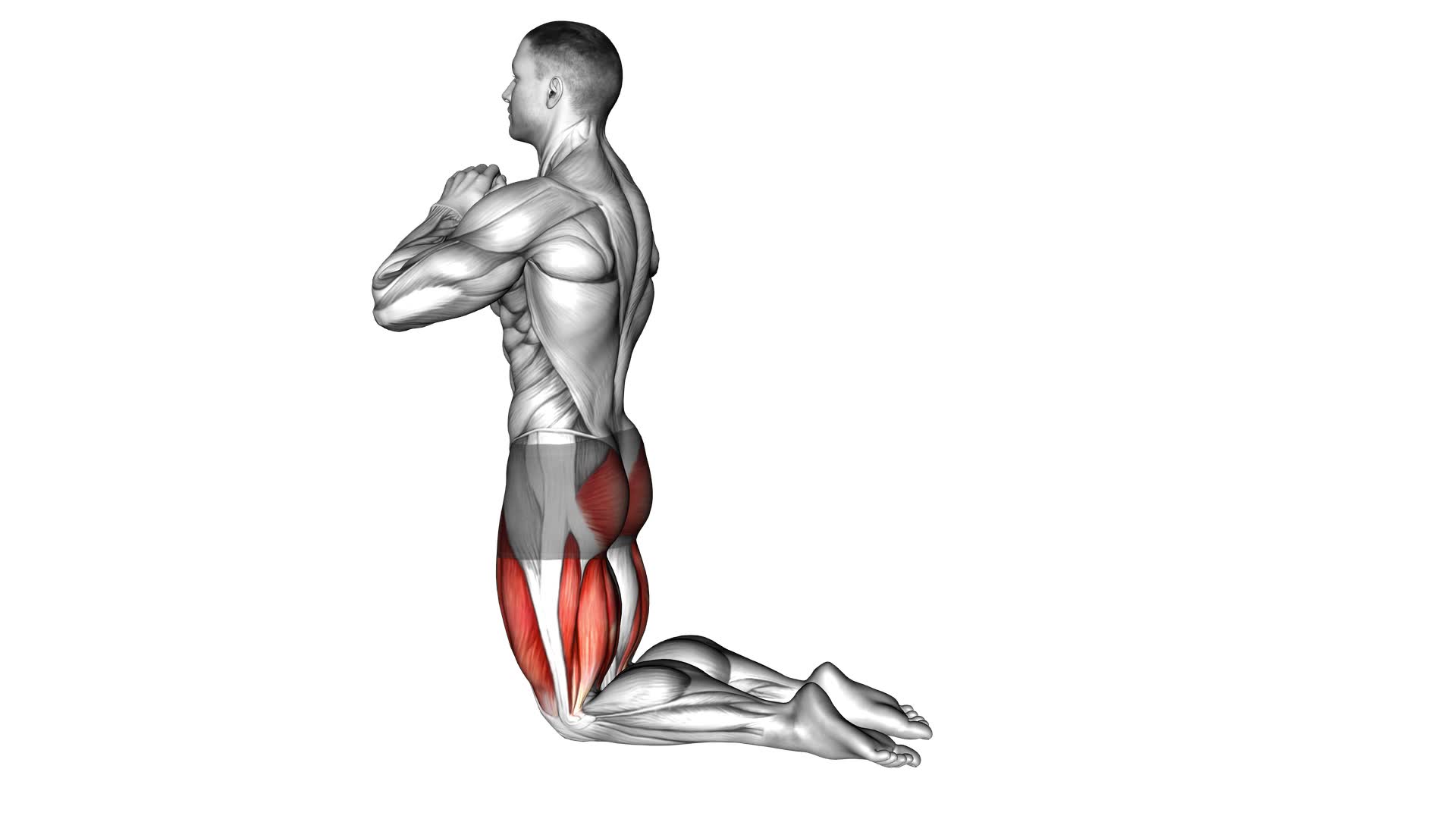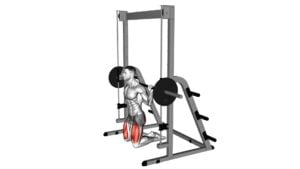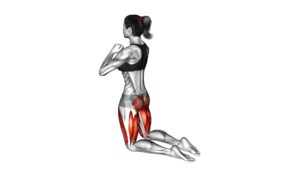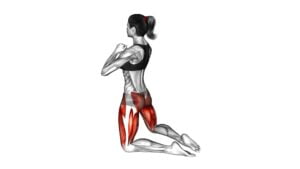Kneeling Hip Thrust (male) – Video Exercise Guide & Tips

Are you looking to strengthen your glutes and improve your lower body strength? Look no further than the kneeling hip thrust.
Watch This Exercise Video
In this video exercise guide, we'll show you the proper form and technique to perform this effective exercise. With just a few simple variations and some expert tips, you'll be on your way to maximizing your results and taking your workouts to the next level.
So grab a mat and let's get started!
Key Takeaways
- Kneeling hip thrusts engage glutes, hamstrings, and core muscles, helping to strengthen and tone the lower body.
- This exercise maximizes gains, improves posture, and enhances hip extension for running, jumping, and squatting.
- Proper form and technique, such as engaging the core, maintaining a straight line from knees to shoulders, and avoiding arching or hyperextending the spine, are crucial for preventing injuries and maximizing results.
- Variations and progressions, such as single-leg kneeling hip thrusts and weighted kneeling hip thrusts, can increase glute activation and intensity, while incorporating resistance bands or weights can further challenge the muscles.
Benefits of the Kneeling Hip Thrust
You can experience several benefits from incorporating the kneeling hip thrust into your exercise routine. This exercise is highly effective in maximizing gains and improving posture. When you perform the kneeling hip thrust, you engage your glutes, hamstrings, and core muscles, helping to strengthen and tone these areas. By targeting these muscle groups, you can achieve a more sculpted and defined lower body.
In addition to its aesthetic benefits, the kneeling hip thrust also has functional advantages. It enhances your hip extension, which is crucial for activities such as running, jumping, and squatting. Strong hip extension not only improves athletic performance but also reduces the risk of injuries.
Furthermore, incorporating the kneeling hip thrust into your routine can help correct poor posture. This exercise strengthens the muscles responsible for maintaining proper alignment and stability in your pelvis and spine. By improving your posture, you can alleviate discomfort and prevent future issues such as back pain.
To maximize the gains from the kneeling hip thrust, it's important to perform the exercise with proper form and technique. Start with a weight that challenges you but allows you to maintain control throughout the movement. Gradually increase the weight as your strength improves. Remember to engage your core muscles and keep your spine neutral throughout the exercise.
Proper Form and Technique
To ensure optimal results and minimize the risk of injury, it's essential to maintain proper form and technique while performing the kneeling hip thrust exercise. By paying attention to your form, you can target the correct muscles and avoid strain or injury. Here are some injury prevention techniques and tips for maximizing your results:
- Begin by kneeling on a mat with your knees hip-width apart and your toes pointed. This position will help stabilize your body throughout the movement.
- Place your hands on your hips or hold onto a stable surface for support. This will help you maintain balance and control during the exercise.
- Engage your core muscles by pulling your belly button in towards your spine. This will provide stability and protect your lower back.
- As you raise your hips, focus on squeezing your glutes and driving through your heels. This will activate your glute muscles and maximize the effectiveness of the exercise.
- Avoid arching your back or hyperextending your spine. Keep your body in a straight line from your knees to your shoulders.
Equipment Needed for the Exercise
To perform the kneeling hip thrust exercise effectively, there are a few essential pieces of equipment you'll need. These include:
- A bench or stable elevated surface
- A resistance band or barbell
- A mat or towel for added comfort
If you don't have access to a bench, you can use a sturdy chair or even the edge of your bed as an alternative.
Remember to prioritize safety by ensuring the stability of your chosen equipment and maintaining proper form throughout the workout.
Essential Equipment for Exercise
To perform the kneeling hip thrust exercise, you'll need one piece of essential equipment. The main equipment option for this exercise is a barbell. A barbell provides the necessary resistance and stability to effectively engage your glutes and hips.
However, if you don't have access to a barbell, there are budget-friendly alternatives that you can consider. One option is using dumbbells or kettlebells. Simply hold the dumbbells or kettlebells on your hips as you perform the exercise.
Another option is using a resistance band. Place the band just above your knees and push against the resistance as you thrust your hips forward.
These alternatives can still provide a challenging workout for your glutes and hips without the need for expensive equipment.
Alternatives to Expensive Gear
If you don't have access to expensive gear, consider using alternative equipment for the exercise. Here are some budget-friendly options and DIY alternatives to help you achieve the kneeling hip thrust:
- Resistance bands: These versatile bands provide the necessary resistance for the exercise and can easily be found at an affordable price.
- Dumbbells or kettlebells: If you have access to these weights, they can be used to add extra resistance to the exercise.
- Sandbags or backpack filled with books: These makeshift weights can be used to add resistance and mimic the effect of expensive gym equipment.
- Stability ball: Using a stability ball instead of a bench can provide support and stability during the exercise.
By utilizing these budget-friendly options and DIY alternatives, you can still perform the kneeling hip thrust effectively without breaking the bank.
Now, let's move on to the next section about safety precautions during your workout routine.
Safety Precautions During Workout
When performing the kneeling hip thrust exercise, it's important to ensure you have the necessary equipment for a safe and effective workout.
To start, you'll need a sturdy bench or elevated surface to lean against. This will provide stability and support throughout the exercise.
Additionally, you'll need a barbell or dumbbell to add resistance to the movement. Choose a weight that challenges you but still allows for proper form.
Before starting the exercise, it's crucial to warm up your body with dynamic stretches and mobility exercises. This will help increase blood flow to the muscles and prepare them for the movement.
Lastly, if you have any specific limitations or injuries, it's recommended to consult with a fitness professional for appropriate modifications to ensure a safe workout.
Variations and Progressions
How can you advance your kneeling hip thrust exercise?
Once you have mastered the basic form of the kneeling hip thrust, you can progress and challenge yourself by incorporating modifications and variations. Here are some ways to take your kneeling hip thrusts to the next level:
- Single-leg kneeling hip thrusts: Lift one leg off the ground and perform the exercise with only one leg. This variation increases the activation of your glutes and challenges your stability.
- Weighted kneeling hip thrusts: To increase the intensity, you can place a weight plate or a dumbbell on your hips while performing the exercise. This adds resistance and helps to build more strength and muscle.
- Banded kneeling hip thrusts: Loop a resistance band around your thighs, just above your knees, and perform the exercise. The band provides additional resistance, targeting your glute muscles even more.
- Elevated kneeling hip thrusts: Place your feet on an elevated surface, such as a step or a bench, and perform the exercise. This variation increases the range of motion and further engages your glutes.
Common Mistakes to Avoid
To ensure proper form during the kneeling hip thrust exercise, it's important to pay attention to a few key points.
First, make sure your back is straight throughout the movement to avoid any unnecessary strain on your spine.
Additionally, engage your glutes and core muscles to prevent relying too heavily on your lower back.
Proper Form Demonstration
To achieve proper form during the kneeling hip thrust exercise, focus on keeping your back straight and using a controlled motion throughout the movement. Here are some tips to help you maintain proper form and get the most out of this exercise:
- Engage your glutes and core by squeezing them throughout the movement.
- Keep your shoulders down and back to maintain stability.
- Avoid overarching your lower back by tucking your tailbone under and maintaining a neutral spine.
- Make sure your knees are at a 90-degree angle and aligned with your ankles.
By following these tips, you can ensure that you're performing the kneeling hip thrust correctly and effectively.
Now, let's move on to the next section where we'll discuss injury prevention techniques.
Injury Prevention Techniques
To prevent injuries while performing the kneeling hip thrust, focus on maintaining proper form and avoiding common mistakes.
Proper form is crucial in preventing injuries during this exercise. Make sure to keep your back straight and your core engaged throughout the movement. Avoid arching your back or rounding your shoulders, as this can put undue stress on your spine. It's also important to use a controlled and smooth motion, rather than jerking or thrusting forcefully.
Additionally, be mindful of your knee alignment and avoid letting them collapse inward.
Injury prevention strategies for the kneeling hip thrust include gradually increasing the weight or resistance used, warming up properly before exercising, and listening to your body's signals of pain or discomfort.
Tips for Maximizing Results
Maximize your results by incorporating these five tips into your kneeling hip thrust routine.
- Vary the intensity: To maximize your results, try incorporating different levels of intensity into your kneeling hip thrust routine. You can do this by adding resistance bands or weights to increase the load on your muscles. This will help you challenge your muscles and stimulate growth.
- Increase workout frequency: Consistency is key when it comes to getting results. Aim to perform kneeling hip thrusts at least two to three times a week. This frequency will ensure that your muscles are being consistently stimulated, leading to better results over time.
- Focus on proper form: It's important to maintain proper form throughout your kneeling hip thrusts. This means keeping your core engaged, your back straight, and your glutes fully activated. By focusing on proper form, you'll target the correct muscles and avoid injury.
- Gradually increase repetitions and sets: As you progress in your kneeling hip thrust routine, gradually increase the number of repetitions and sets you perform. This progressive overload will help you continue to challenge your muscles and promote growth.
Frequently Asked Questions
How Many Sets and Reps Should I Do for the Kneeling Hip Thrust Exercise?
To get the most out of the kneeling hip thrust exercise, it's important to consider the number of sets and reps.
The optimal range for this exercise is typically around 3-4 sets of 8-12 reps.
This will help to target and strengthen your glutes, hamstrings, and core muscles.
Can Women Also Perform the Kneeling Hip Thrust Exercise?
Women can definitely perform the kneeling hip thrust exercise. It offers various benefits, such as targeting the glutes and hamstrings, improving hip stability, and enhancing overall lower body strength.
To modify the exercise, you can use a resistance band or add weights to increase intensity. Remember to maintain proper form and engage your core throughout the movement.
Incorporating this exercise into your workout routine can help you achieve your fitness goals.
Is It Normal to Feel Discomfort in the Knees While Performing the Kneeling Hip Thrust?
Feeling discomfort in your knees during the kneeling hip thrust isn't normal and may indicate improper form. To avoid this, ensure that your knees are properly aligned and not bearing excessive weight. You can try adjusting your foot placement or using a mat to provide cushioning.
Remember to engage your glutes and core muscles while performing the exercise. If the discomfort persists, it's recommended to consult with a fitness professional for form correction.
How Often Should I Include the Kneeling Hip Thrust Exercise in My Workout Routine?
To optimize your workout routine, it's important to include the kneeling hip thrust exercise at the right frequency.
This exercise targets your glutes and can be done 2-3 times a week for best results.
To add more challenge, you can try variations like using resistance bands or adding weights.
Remember to maintain proper form and listen to your body to avoid any discomfort or injury.
With consistency, you'll see improvements in your lower body strength and shape.
Are There Any Specific Breathing Techniques I Should Follow During the Kneeling Hip Thrust Exercise?
When doing the kneeling hip thrust, it's important to focus on your breathing technique. Take a deep breath in as you lower your hips towards the ground, and exhale as you thrust your hips forward. This will help engage your core and stabilize your body during the exercise.
Proper breathing can also enhance the activation of your glute muscles, resulting in a more effective workout. So remember to breathe and get the most out of your kneeling hip thrusts!
Conclusion
In conclusion, the kneeling hip thrust is an effective exercise for targeting the glutes and improving lower body strength. By maintaining proper form and using the appropriate equipment, you can maximize the benefits of this exercise.
Remember to avoid common mistakes and progress gradually to more challenging variations. With consistent practice and attention to detail, you can achieve great results and enhance your overall fitness level.

Author
Years ago, the spark of my life’s passion ignited in my mind the moment I stepped into the local gym for the first time. The inaugural bead of perspiration, the initial endeavor, the very first surge of endorphins, and a sense of pride that washed over me post-workout marked the beginning of my deep-seated interest in strength sports, fitness, and sports nutrition. This very curiosity blossomed rapidly into a profound fascination, propelling me to earn a Master’s degree in Physical Education from the Academy of Physical Education in Krakow, followed by a Sports Manager diploma from the Jagiellonian University. My journey of growth led me to gain more specialized qualifications, such as being a certified personal trainer with a focus on sports dietetics, a lifeguard, and an instructor for wellness and corrective gymnastics. Theoretical knowledge paired seamlessly with practical experience, reinforcing my belief that the transformation of individuals under my guidance was also a reflection of my personal growth. This belief holds true even today. Each day, I strive to push the boundaries and explore new realms. These realms gently elevate me to greater heights. The unique combination of passion for my field and the continuous quest for growth fuels my drive to break new ground.







